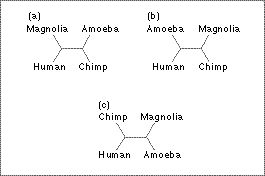Parsimony

Parsimony is a fundamental principle to phylogenetic inference in which the phylogeny of a group of species is inferred to be the branching pattern requiring the smallest number of evolutionary changes.
Phylogenetic inference using parsimony proceeds in two stages:
1. Infer the unrooted tree for a set of species. An unrooted tree shows the branching relations between the species but does not show the position of the deepest common ancestor. It is a phlogenetic tree with the time dimension removed.
2. Locate the root. This means finding the position of the deepest ancestor, or 'root' within the tree.
Figure: possible phylogenetic relations of amoeba, chimpanzee, human and magnolia. (a), (b) and (c) are three unrooted trees; they specify branching, but not ancestral relations.
| Next |



